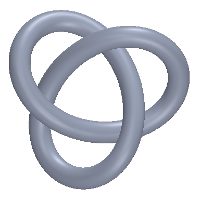I created a set of IBL (inquiry based learning) course materials for MTH 205 (Math for the Modern World) at Creighton University. I have a full course packet available with curriculum materials, homework (through an online platform), and quizzes in a packet suitable for upload into Canvas or a similar platform. Please email me if you would like a copy!

There's no need for a fire drill to interrupt class.
Teaching Philosophy
My teaching philosophy can be seen in the procedure I follow when I teach Calculus III. The beginning of my syllabus lays out several levels of learning I hope the students will pass through during the course. The first step is learning specific definitions and formulae by rote, from the equation for a plane to the dreaded limit definition of the derivative. On the next level, students learn to apply these memorized nuggets of mathematical knowledge in explicit situations. They might calculate the derivative of (2xy-1)/(3x+4y), or they might learn to follow the steps involved in maximizing a two-variable function subject to a constraint. As the basic calculations become more natural and automatic for them, they will (one hopes) also pass to a third stage of learning and develop a richer understanding of how the pieces fit together and how, for example, Lagrange multipliers and gradients encode information about the extrema of a function. Finally, one of the overarching goals of most calculus classes is for students to understand what derivatives and integrals really are to the point where they could go to a different class and encounter a new topic like the cumulative distribution function and actually see fairly quickly how it is related to the probability density function. These are the insights students really need to internalize before going on to many other math, science, and engineering classes, where they can look up formulae but cannot look up what an integral does. Related to this goal is the reason math classes are mandatory for so many other majors, too: they develop a student's ability to approach a new problem rationally, break it up into its component pieces, and analyze each in abstraction from the others.
The most basic math skills are just techniques for manipulating abstract objects. I like to compare this stage of learning to warming up with scales in music, doing drills at the beginning of sports practices, or memorizing new vocabulary for a foreign language class. We only do a few basic drills in class, but almost all of my homework assignments start with a smattering of simple problems like this and a suggestion of additional problems that students can do until the basics come naturally. One excellent resource I have used for this kind of practice is an online program called Webwork. The instructor can choose a template for each problem, and the server generates and grades unique problems for each student. The students get immediate feedback and can correct to 100%, and the instructor and teaching assistants can focus their grading efforts on less mechanical problems.
I have thought extensively about the best ways to help students develop a more sophis- ticated understanding of the mathematical tools they learn and how to help them advance their problem solving and analytical skills. The method that works best for me is to walk students through a problem step by step and let them try each piece on their own; if they can solve each step by themselves, they start building up good problem-solving habits much more quickly than they would watching me do the work. Even when they get stuck, they still see an example of how someone breaks down a problem, solves the pieces, and reconstructs them into a solution. For example, a Calculus I class on related rates could start with a series of problems of slowly increasing complication: A rectangle has width 10. If its height grows by 1ft, how much did its area increase? They can solve this without even writing anything down, and most will even volunteer the answer. If its height is growing at a constant rate of 1ft/min, how is its area changing? Easy enough, and they think about how to relate minutes and feet. Can you write that down using derivatives? They begin to remember they are in calculus class. I write A = w · h and then substitute w = 10, but point out that h and A are changing, so we need to leave them as variables. Then we take an easy derivative, but we notice that we use d/dt, not d/dw or d/dA; we just did implicit differentiation last week, so this is not too upsetting. We start talking about implied variables, like t, and how we would recognize something was wrong if we had taken d/dw by accident. Now say the width is growing by 1ft/min and the height by 3ft/min. How fast is its area growing? Most of the students still do this without assistance. Some ask questions. Does it matter what w and h are? Now we see that w and h are both variables, so we actually use the product rule and realize the answer depends on both variables, which surprises some. So how fast is the area growing when w = 4 and h = 3? They still answer this quickly. Would have been OK to plug in 3 and 4 at the beginning, before we took the derivative? They think the answer is obvious. Say w is 3ft, and dh/dt is 3ft/min again. What if we messed up and used the product rule instead of plugging in w = 3 first? They still think this is obvious, once they notice that dw/dt = 0.
These methods work for all levels of basic undergraduate mathematics and even, with some modification, for a beginning graduate course. One of my favorite classes to teach was Applied Calculus 2 at Indiana University, Bloomington, which was an elective for students in some biology or pre-med majors. The students tended to like math (or at least dislike it less than their other options), but they were often less experienced or less quick with basic math skills. The course did not require as sophisticated an understanding of the basics as, say, normal Calculus 2, but I found that these students were perfectly capable of advancing to the third or fourth levels of learning. As long as I kept the basic techniques less complicated (e.g., I could use e3x but not ex cos x), they could solve otherwise very sophisticated word problems. Best of all, most of them really seemed to enjoy the class and be proud of how much they had learned.
I also strive to improve in a number of characteristics of a good teacher implicit in the goals described above. A course should be well-organized with clear goals and a published schedule (which is followed as closely as possible). Assignments should be relevant and announced in a timely fashion, and grading should be clear and fair as well as give students feedback on how they can improve, not just on whether they are right or wrong. A good teacher needs to be available for office hours and emailed questions, and, above all, must try to remain polite and encouraging, no matter what the temptation is to be otherwise. It is important to remember that the students are, ultimately, the ones who teach themselves, but the educational system is set up (and they participate in it with this expectation) so that the teachers provide the structure and the assistance that students need to do their jobs.

